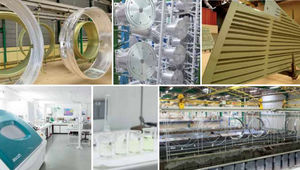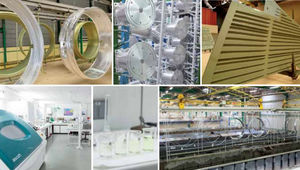
- Industrial machines and equipment
- Surface Treatment
- Sulfuric anodizing
- SGI - Société de Galvanoplastie Industrielle
Sulfuric anodizing aluminumindustrialfor the food industry
Add to favorites
Compare this product
Characteristics
- Type
- sulfuric
- Type of substrate
- aluminum
- Applications
- industrial, for the food industry, automotive, for cosmetics
- Production method
- large series, medium series, small series, individual
- Certifications
- EN 12 373-1, EN 12 373-18, EN 12 373-2 / 17, EN 2284, ISO 9227-NSS
Description
The duration of treatment is 20 to 60 min, the thickness of the oxide film obtained depends on the chemical composition of the alloy and varies according to the application sought and the industrial sector concerned. It is usually 5 to 25 µm. The treatment leads to a swelling equivalent to 33% of the thickness of the film and a slight increase in the surface roughness. The oxide layer is mainly composed of a porous structure. Sealing treatment by hydration of the porous layer is necessary to achieve the maximum corrosion resistance, but paint adhesion decreases significantly. It is possible to colour the coating, a bright metallic colour is obtained by chemical colouration: black, red, blue or green.
Electrolytic colouring, by the deposit of a mixture of oxides and metals, produces shades of gold, bronze and black that are very solid under light. The colouring operation is located before the sealing.
Appearance: metallic grey
Thickness: 5 to 25 µm
Microhardness: 200 / 250 Hv 0.050
Surface condition: slight degradation of the roughness
Electrical insulation: 500 to 1500 volts
Coefficient of friction: good under medium load
Reduction in fatigue: 5 to 40 % in alternating traction, depending on the alloy, may be offset by prior shot peening
Corrosion resistance:
- without sealing: > 100 h (BS ISO 9227 NSS)
- sealing with nickel salt: > 300 h
- sealing with chromium VI salt > 500 h
Catalogs
No catalogs are available for this product.
See all of SGI - Société de Galvanoplastie Industrielle‘s catalogsOther SGI - Société de Galvanoplastie Industrielle products
Treatment by electrolytic conversion
Related Searches
- Anodic oxidation
- Aluminum anodic oxidation
- Painting
- Large series anodic oxidation
- Small series anodic oxidation
- Medium series anodizing
- Painting on metal
- Hard anodizing
- Automotive anodic oxidation
- Industrial anodizing
- Aeronautic anodic oxidation
- Individual anodizing
- Sulfuric anodic oxidation
- Chromic anodic oxidation
- Painting on steel
- Pickling
- Aeronautic painting
- Anodizing for the food industry
- Painting on aluminum
- Steel pickling
*Prices are pre-tax. They exclude delivery charges and customs duties and do not include additional charges for installation or activation options. Prices are indicative only and may vary by country, with changes to the cost of raw materials and exchange rates.





